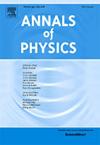熵界与全息暗能量:冲突与一致
IF 3
3区 物理与天体物理
Q2 PHYSICS, MULTIDISCIPLINARY
引用次数: 0
摘要
Cohen, Kaplan和Nelson的有影响力的论文建立了紫外-红外截止值不能任意选择,而是受到Λ2L > Mp关系的约束。在这里,我们重新审视CKN熵界的公式,并将其与其他界进行比较。每个边界的具体特征取决于熵的基本尺度。值得注意的是,采用冯·诺伊曼熵定义的非扩展缩放产生了一个更严格的约束,Smax≈SBH,其中SBH是贝肯斯坦-霍金熵。我们还澄清了这些框架中使用的红外截止点之间的区别。移动到因果熵界,我们证明了它将CKN界分类为类物质,冯·诺伊曼界分类为类辐射,贝肯斯坦界分类为饱和时的类黑洞系统。强调宇宙学意义,我们确认边界和视界热力学第一定律之间的一致性。然后,我们分析了标准全息暗能量(HDE)模型的缺点,强调了使用Λ2L > Mp构建HDE的挑战。具体来说,在HDE定义中使用哈勃函数引入了循环逻辑,导致暗能量模仿第二个主要成分,而不是表现为物质。我们进一步说明,其他红外截止点的潜力,如FLRW背景下的未来事件视界或涉及哈勃函数导数的事件视界,解释晚时间加速源于一个不能简单地设置为零的积分常数。简而言之,CKN关系并不指定任意的宇宙学常数;它解释了为什么它的值很小。本文章由计算机程序翻译,如有差异,请以英文原文为准。
Entropy bounds and holographic dark energy: Conflicts and consensus
Cohen, Kaplan, and Nelson’s influential paper established that the UV–IR cut-offs cannot be arbitrarily chosen but are constrained by the relation . Here, we revisit the formulation of the CKN entropy bound and compare it with other bounds. The specific characteristics of each bound are shown to depend on the underlying scaling of entropy. Notably, employing a non-extensive scaling with the von Neumann entropy definition yields a more stringent constraint, , where is the Bekenstein–Hawking entropy. We also clarify distinctions between the IR cut-offs used in these frameworks. Moving to the causal entropy bound, we demonstrate that it categorises the CKN bound as matter-like, the von Neumann bound as radiation-like, and the Bekenstein bound as black hole-like systems when saturated. Emphasising cosmological implications, we confirm the consistency between the bounds and the first laws of horizon thermodynamics. We then analyse the shortcomings in standard Holographic Dark Energy (HDE) models, highlighting the challenges in constructing HDE using . Specifically, using the Hubble function in HDE definitions introduces circular logic, causing dark energy to mimic the second dominant component rather than behaving as matter. We further illustrate that the potential for other IR cut-offs, like the future event horizon in an FLRW background or those involving derivatives of the Hubble function, to explain late-time acceleration stems from an integration constant that cannot be trivially set to zero. In brief, the CKN relation does not assign an arbitrary cosmological constant; it explains why its value is small.
求助全文
通过发布文献求助,成功后即可免费获取论文全文。
去求助
来源期刊

Annals of Physics
物理-物理:综合
CiteScore
5.30
自引率
3.30%
发文量
211
审稿时长
47 days
期刊介绍:
Annals of Physics presents original work in all areas of basic theoretic physics research. Ideas are developed and fully explored, and thorough treatment is given to first principles and ultimate applications. Annals of Physics emphasizes clarity and intelligibility in the articles it publishes, thus making them as accessible as possible. Readers familiar with recent developments in the field are provided with sufficient detail and background to follow the arguments and understand their significance.
The Editors of the journal cover all fields of theoretical physics. Articles published in the journal are typically longer than 20 pages.
 求助内容:
求助内容: 应助结果提醒方式:
应助结果提醒方式:


